Transcript of Speech by Deputy Prime Minister and Minister for Finance Tharman Shanmugaratnam at NTUC Ordinary Delegates' Conference on Tuesday 29 October 2013, 10.20am at Orchid Country Club
29 Oct 2013
Sister Diana Chia, President, NTUC
Brother Lim Swee Say, Secretary-General, NTUC
Brother Tan Chuan-Jin, Acting Minister for Manpower
Brother Stephen Lee, President, SNEF
NTUC Central Committee Members
Parliamentary colleagues
Distinguished Guests
Brothers and Sisters
1. Thank you for inviting me to join you at this ODC, which comes at an important time for Singapore and in fact an important point for the world economy. Before I go on, let me say to our Hindu brothers and sisters, Happy Deepavali!
2. NTUC, as we know, is at the heart of what we are trying to achieve in Singapore: to build an inclusive society, a Singapore that is better for all Singaporeans. And workers are at the core of this. Workers are not just an essential part of the economy; they are at the core of Singapore society. So everything to do with workers – wages, employment conditions, the workplace environment – everything to do with workers is at the core of what we are trying to do in building an inclusive society.
3. NTUC has been working tirelessly, with new initiatives, with employers, with Government, to push the boundaries and make sure that we achieve real progress, not just in words but in reality: better jobs and better pay, and especially for our low income workers. So I first want to give credit to NTUC, not just for being part of our tripartite coalition, but for being at the leading edge of tripartism.
The Global Challenge - Jobs and Incomes
4. What is it we are trying to achieve? In every country, what people hope an economy can deliver is, firstly, jobs. And secondly, better jobs, with better incomes for their citizens. That’s what all countries want, jobs and better incomes for their citizens. This means trying to keep unemployment low, and trying to have incomes grow, not a temporary spurt, but incomes growing steadily year after year, decade after decade especially for the average citizen and those lower down in the income band. This is what virtually all countries want, regardless of ideological persuasion.
5. But this is, in fact, something very few economies have been able to deliver in the new global era, and few especially amongst economies that are relatively advanced or have gone beyond the middle-income level. Very few have been able to deliver both low unemployment, with jobs available for those who need them, as well as improvement in incomes and in the quality of life for the average citizen.
6. Let me give you some examples. Let’s start with the United States [Chart 1], the largest economy in the world. Unemployment rate has improved – it was closer to 10% at the peak of the crisis, it has now improved to about 7.6%. But
this figure is not all that it looks like. The improvement in American unemployment rates has not been due to more jobs being created, but more people leaving the labour force. Because people have been dropping out of the labour force, the unemployment
rate has been improving. So the true unemployment rate, adjusted for those dropping out, is still close to 10%. That is the reality in the US. It used to have lower unemployment rates than Europe, around 5%, now it has a true unemployment situation
of close to 10%. This is a new situation for the United States.
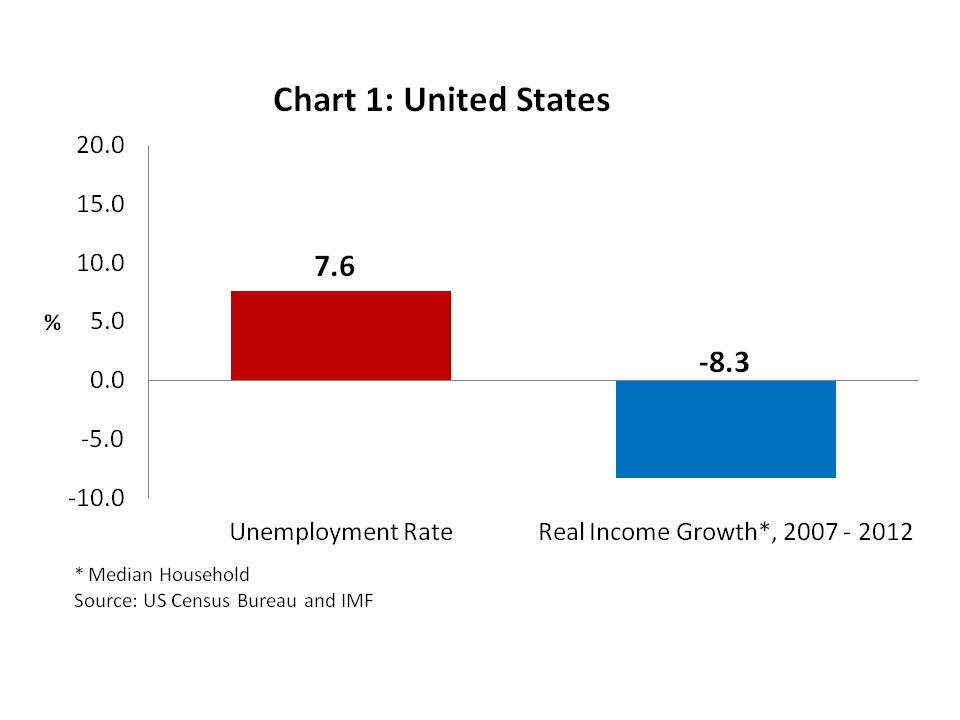
7. Unfortunately, it’s not just an unemployment problem; it is also an income problem. The average worker in the US, the median household, at the chart puts it on the right hand side; the median household has seen a decline in their real incomes. It’s not just in the last five years. The median household has seen no improvement in incomes now for two decades or more. And this too is a new situation for the US, because the US was always a place where average workers were able to move ahead in life if they worked hard. It is no longer possible now. First, it is difficult to get a job once you lose one. Second, even if you get a job there is no assurance that your incomes are going to improve.
8. Next the UK [Chart 2]. Very similar situation. I won’t go through the details, but unemployment is about 7.7% and the incomes picture in the last five years was poor – they had negative income growth.
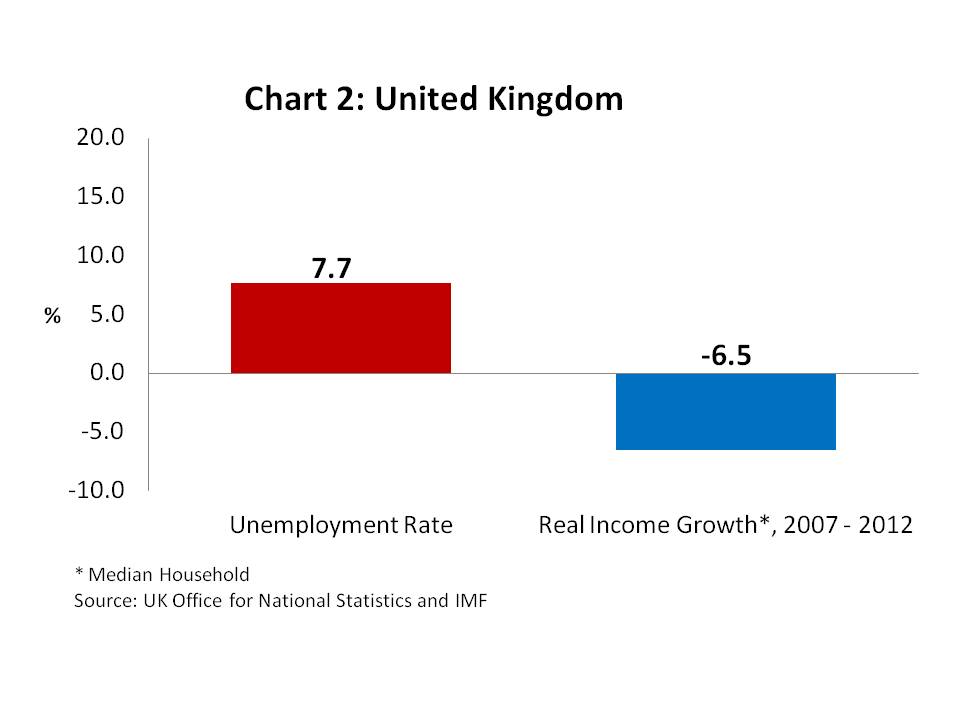
9. We move on to Germany [Chart 3], widely regarded as one of the more competitive and better performing EU countries. Their unemployment rate is relatively low – it has fallen to 5.3%. But even there, I have to say that the figures are
not what all they seem. Germany has achieved a low unemployment rate by creating what they call ‘mini jobs’. These are jobs where pay is restricted to a maximum of 450 Euros, which is about 750 in Singapore dollars. The maximum pay is
750 dollars and they don’t pay income taxes. They still have to pay VAT, but no income tax. They have grown a very large number of these ‘mini jobs’, such that today, one-fifth, that is one out of every five German workers,
is on a mini job with low wages. That is how they have achieved an unemployment rate of 5.3% – better than other EU countries but at the expense of low wages. And even the average household has seen very little income growth, as the chart
shows. That’s Germany, one of the most successful industrial economies.
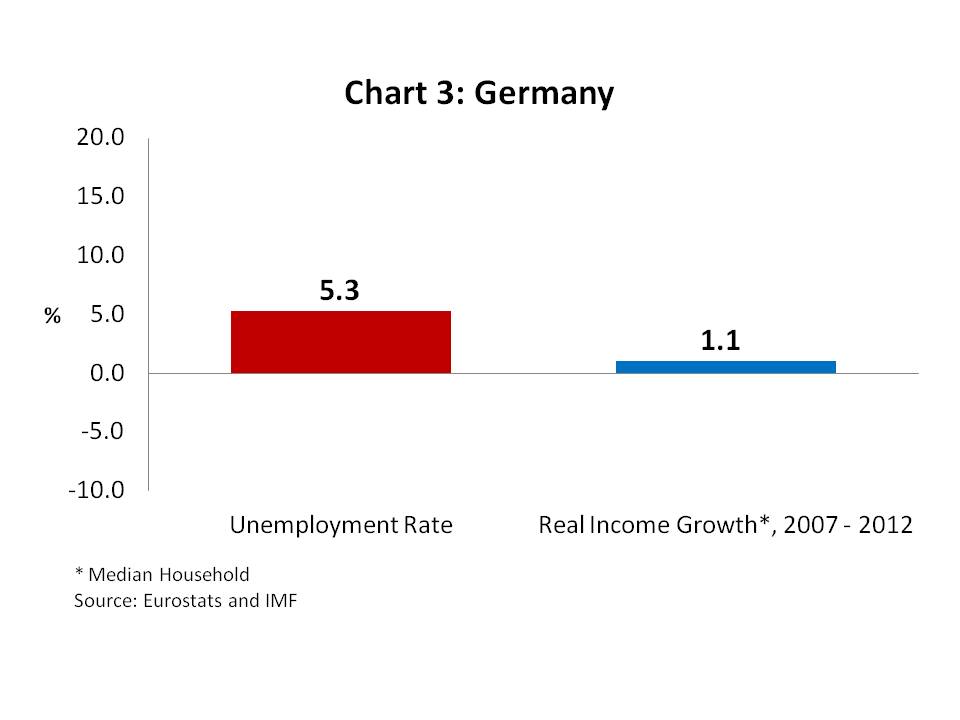
10. Japan [Chart 4] is doing a little better now because they went through a period of stagnation for about two decades and now hopefully are coming out of it. They have had a low unemployment rate traditionally, but even in Japan, income growth
is a problem for the average family. Real incomes have not been growing – in fact in the last five years they have fallen even further.
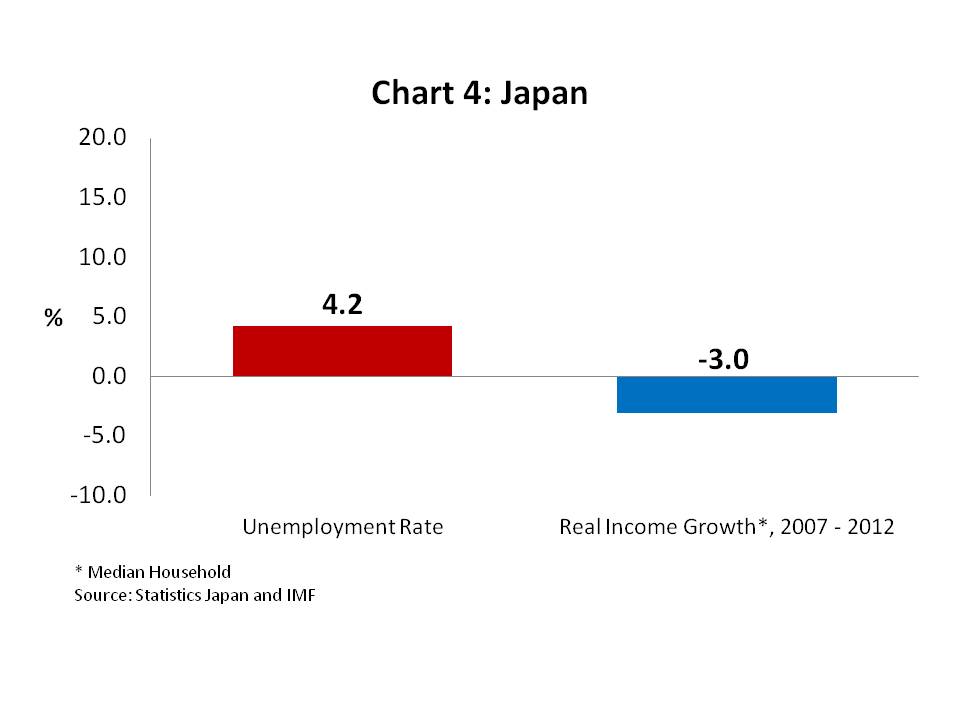
11. Let me move on to some of the dynamic Asian countries, especially the Asian NIEs: Hong Kong, Korea, Taiwan and Singapore. We have been doing better, but because our incomes are a little lower than in the most advanced economies, we should be achieving better income growth than them.
12. And as you can see if you look at Hong Kong, a low unemployment rate, and they have achieved some income growth for the average household, about 6% in real terms in the last five years. Korea, very similar, low unemployment and some real income
growth, about 7%. Taiwan – not so good, unemployment a little higher than Singapore, Hong Kong and Korea, but income growth in Taiwan has been a problem for a long time. The chart shows the last five years but even if you look at it for
the last 10 to 15 years, real incomes have stagnated in Taiwan for the average family [Charts 5A, 5B, 5C].
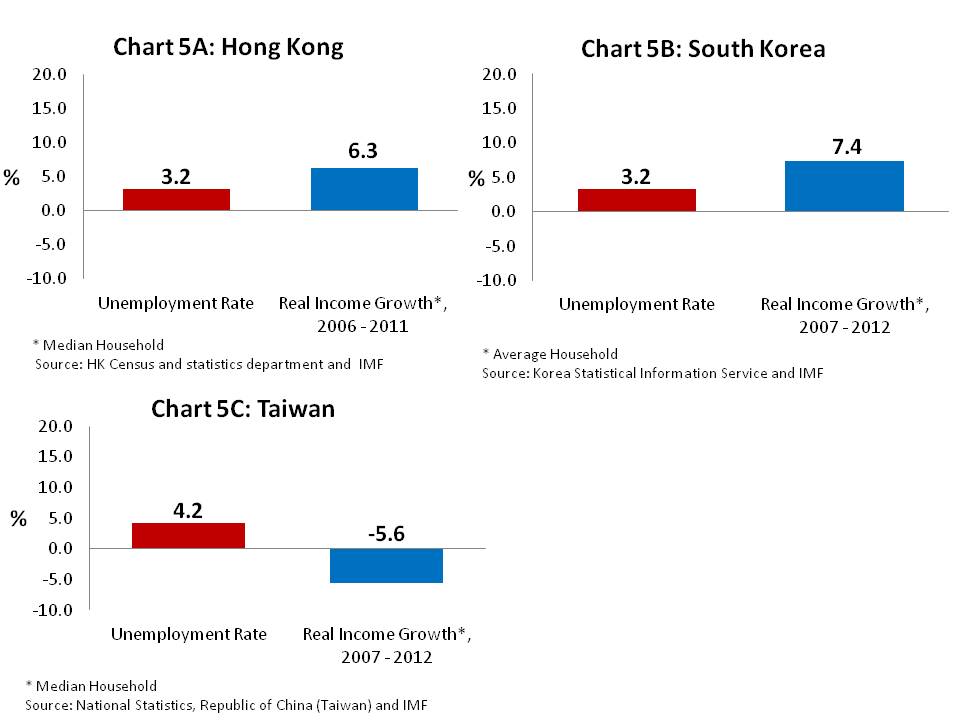
13. And then we have Singapore [Chart 6]. Unemployment is low, and we have also achieved very good growth of real incomes in the last five years for the average Singaporean household. For the median household, which is the household right in the
middle of the income distribution, we have achieved significant real income growth in the last five years, about 18%.
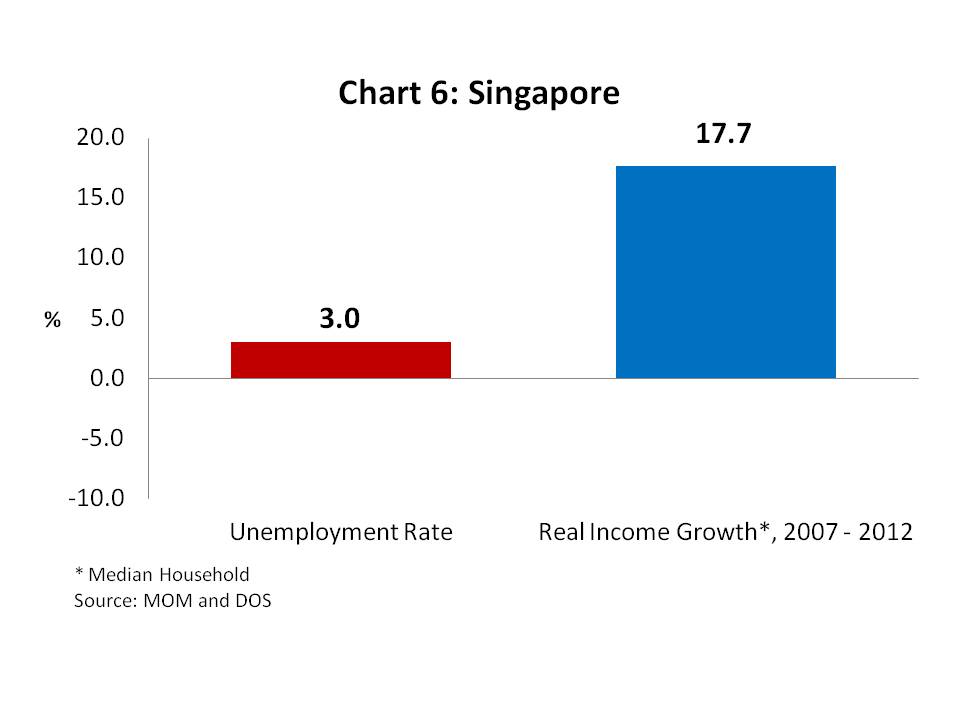
14. What we have achieved is not normal. It is not normal amongst countries that are in the same league as us [Table 1]. And it means, first of all, that we must be doing some things right. We can’t be doing everything wrong, because we would
not be in this very unusual situation of having low unemployment and significant income growth, a better situation than these other economies.
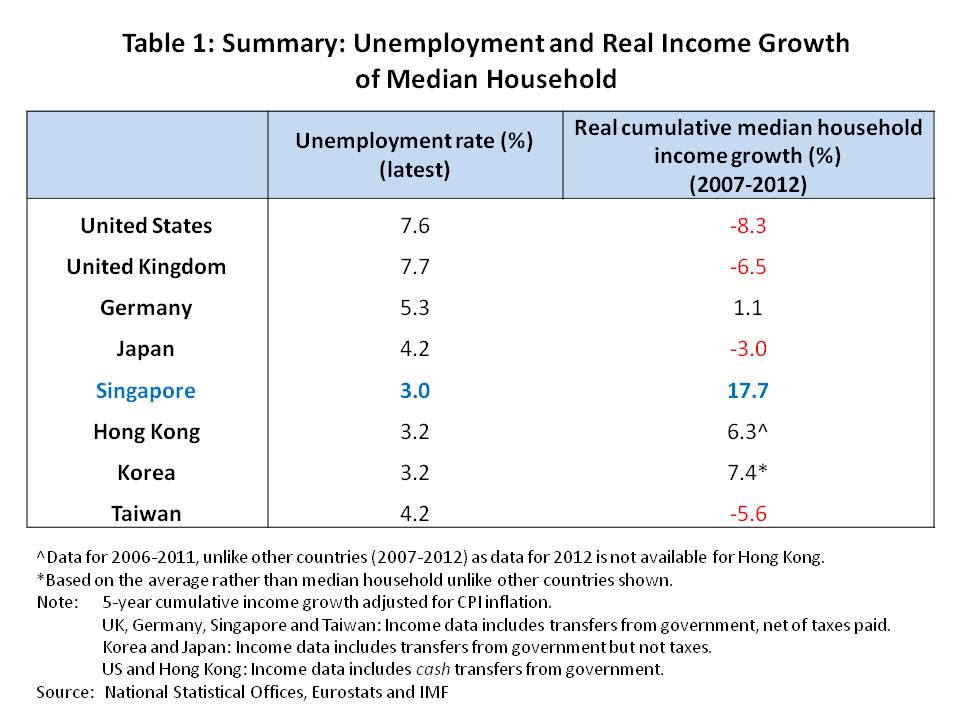
15. And one of the things we have been doing right is to keep a harmonious relationship between businesses, labour and the Government. That is one of the things at the core of what we are doing right. Sometimes, from year to year, we may not do well, but if we look at it over five years, 10 years, 15 years, we have been doing better than most countries. And it’s hard to escape the conclusion that our way of working together – between the labour movement and business, between the government and business and the labour unions – has had something to do with what we are achieving.
16. But I also show this data from the other countries not to say that we are better, but so that we all recognise the forces in the global economy that have led to these countries seeing little income growth for average households, and in many cases high unemployment. We are in the same world as the rest of them, and the reasons why they are under pressure will also apply to us. We will have to work even harder to avoid what has happened in these countries – to make sure that we continue to be a country with low unemployment and good income growth for the average citizen and family, and for our low-income families.
17. We are in the same world as them, the same world where China and the emerging markets are taking more jobs and more market share; and the same world where technologies are reshaping work, including technologies that are only beginning to impact significantly – robotics, Artificial Intelligence (AI), big data, and other new technologies that are removing jobs because machines and AI can do the jobs cheaper than human beings. This is happening now in the developed countries and we will see these pressures in Asia and in our economy in the years to come.
18. So we are not living in a different world. We are in the same world and face the same competitive pressures, and the same risks and opportunities coming out of technology. So we will have to work hard and work in our own unique way to ensure that Singapore remains a place where we have low unemployment, and we can provide improvement in living standards for average families and our lower income families. So that’s the reason I show this data – not to show that we are superior, but to show that we have to work very hard to keep this going.
Three Key Strategies
19. What this means, as we go forward, is that we must stay focused on three types of strategies. First, we must ensure that we are a thriving and competitive economy. We must always be looking out for opportunities – opportunities to bring in new investments that are high quality and that can create better jobs, and opportunities to take advantage of demands created by the rising middle class in Asia, especially in China, South East Asia and India. Huge new demand in Asia.
20. But we can’t just sit and wait for the opportunities to come; we have to go out and seize them. Our businesses, government working with businesses, unions working with businesses to make sure we can take advantage of these opportunities. So our growth strategies are the first essential – staying competitive and taking advantage of opportunities. That is the first plank.
21. The second plank is to achieve quality growth: growth that is based on productivity improvements, and not just expanding the workforce. We all know that. We must go for quality growth, based on productivity improvements and growth that all Singaporeans can benefit from, especially the average worker and low-income worker. That’s quality growth.
22. And third, we have to ensure through our social policies that we build and stay an inclusive society. A society where people feel they have a responsibility for each other, at the workplace, in the neighbourhood, and in the community generally. We are all responsible for each other.
23. Social policies are important as we go forward, to keep that glue in our society. Because we are unlike other cities which have also seen widening inequality over the last two decades – London, New York, Hong Kong – these are all part of much larger countries. Even Hong Kong is part of China. New York is part of a continental-scale nation. We are 700 square kilometres. Rich and poor, people of different backgrounds, we are all on this small island together, just a few MRT stops away from each other. So social cohesion is more important for Singapore than it is for these other cities. And this third prong therefore is very important.
24. But these three sets of strategies are closely intertwined. They are bound up with each other. If we don’t stay competitive and don’t seize new growth opportunities, then merely achieving productivity growth does not achieve our objectives, because you can achieve productivity growth by shedding jobs and growing the ranks of the unemployed. This is in fact what has happened in the United States; they have had good productivity growth in the last few years because they shed jobs and people were left unemployed. We want productivity growth, but also we want low unemployment. And for that we must have a competitive and thriving economy.
25. But it is also the case that if we want a cohesive and inclusive society, we must have a vibrant economy, because without a vibrant economy, we cannot create good jobs for the average citizen and for the low-income citizen. And all of us can remember what happened 10 years ago when we went through two recessions; it was low-income Singaporeans who suffered the most. The low-income household always suffers the most when we get a bad downturn. So we have got to ensure that we keep our economy competitive and vibrant, because that too is the basis for an inclusive society. A thriving economy and an inclusive society are really one and the same strategy at the end of the day.
Productivity – a lot more work to do
26. Productivity growth: we have a lot more work to do. We had a good recovery from the crisis with a very good improvement in productivity but that was largely cyclical. In the last few years, we’ve had weak productivity growth. Some industries have done well, particularly some manufacturing industries like precision engineering. Some have not done well. And we have to work harder to address this.
27. The key weaknesses are in construction and several services industries such as F&B. These are industries where productivity to begin with is at a lower level. But they are also where we have seen the most rapid employment growth and limited growth of productivity. We have to do more to tackle this problem.
28. We want to help every firm to upgrade, and help every worker to pick up new skills and develop expertise. You know the incentives, you know the schemes and I don’t need to go through them. We will be as aggressive as it takes, to support upgrading, on the job, outside the job and every form of upgrading by firms. But it is not just about effort by individual firms and the individual workers. That’s important but it’s not just the individual firm and individual worker, because broad-ranging productivity improvement also requires innovation across whole sectors and in some aspects, across a whole economy. We need systemic improvements in order to make breakthroughs in productivity.
29. I will give three examples of areas that we are working on to achieve this. The first is in what you might call the back end of the economy – logistics. The front end has businesses dealing with the consumers. You go to a retail shop, this is the front end; or in financial services, you call up your broker, you want to get a loan, that is the front end. But the back end of the economy is very important. It is not business-to-consumer, but business-to-business linkages, B-to-B as they call it. It is a very important part of productivity improvement. Take logistics, a fragmented industry, with some competitive strong players but many smaller players struggling to survive, small companies owning a few trucks for example. Every individual company has to upgrade to cope with labour shortages, but we also need systemic changes that help the whole supply chain to move up. Greater use of IT and technologies is an important part of this strategy. We have started with the air cargo industry, we have an initiative called e-freight@Singapore for data integration, which has worked quite well. We will be working with the rest of the logistics industry, to help every player upgrade but also to use technologies and adopt standards that enable not just the individual firms but the whole chain to be upgraded.
30. A second example is in construction. Again, we see contractors under pressure - shortage of labour, costs are going up, our foreign worker levies are going up. Many contractors are squeezed, especially the smaller ones. But our level of productivity in construction is low compared to the world leaders. When you look at these leaders, one important change and in fact a very important driver is not just what happens downstream when the construction companies and workers are doing the work on the construction site, it is what happens upstream, when the designs are created, when the developer commissions the project, when the consultants and architects get involved, that is critical for construction sector productivity. We are focusing on improving upstream design processes, so as to make it easier for contractors to improve productivity downstream.
31. BCA has already tightened what they call the ‘buildability’ rules. This is a framework that is applied to the developers and architects so that when buildings are designed, they are designed so that you can build them with less manpower and with more efficient technologies and materials. We have tightened the buildability framework for developers, but we intend to tighten it further. We are studying this carefully across the whole construction sector to see what more we should do to tighten the buildability framework so that all stakeholders, not just the construction companies, are in this together, starting with the developer itself.
32. Third example: the retail sector. Again facing a lot of pressure, because of the shortage of labour but also because of increased competition from the region and from online retail. But there is opportunity for our retail sector, particularly the more dynamic players, and we will be working with them to help them not just upgrade in brick and mortar shops, but also helping them to develop what those in the business call omni-channel retailing – using many different channels including online retail, to serve Singaporeans, and also to find new ways to extend their reach into overseas markets. Online retail is in fact common now in the US, and is becoming common in Korea. We have some advantages in Asia, and we will see how to help the retail industry develop these platforms.
33. Three examples – the back-end or logistics side of the economy; secondly construction, working upstream; thirdly in the retail business, developing new platforms and technologies that allow Singapore retailers to thrive in a new landscape.
Three examples that we are working on, working with a broad range of industry stakeholders. It is an important complement to encourage individual companies to upgrade.
Low-Income Workers
34. Let me move on now to what we are doing to help three key groups in our society: low-wage workers, older workers and middle-income workers. If you go back to the first set of charts I showed – how can we remain a place where unemployment remains low and whether you are a low-wage worker, you are an older worker or a PMET, you can find a good job and your income can move up over time? How can we remain that sort of economy – it is a challenge, and we are responding to it.
35. First, low-wage workers. The core of our strategies to help them has to be about skills. We have to help every worker upgrade, with skills relevant to the job. And again, we will be as aggressive as it takes – in supporting CET, Continuing Education and Training. We have had a good start. We are now developing many more training programmes that are relevant to the job, not just generic training but specific, relevant to the job. This includes, importantly, providing better support for on-the-job training, not just training through courses taken outside the workplace. On-the-job training – we are looking into how we can develop that into a real discipline, and where possible have it certifiable so that when workers move from one company to another over the course of their career, the on-the-job training is something they take with them and is part of a continuous spiral of upgrading. This is a very important priority for us.
36. Second, we do have a problem with some low-wage jobs, which have been stuck at low levels for too long.
37. Overall, our low-wage Singaporeans have seen significant improvement. I say this before getting into the problems. Over the last 20 years, lower income households in Singapore, households that are at the bottom 20 per cent, have seen their incomes improve by 60 per cent in real terms. There are a number of reasons why this has happened. First because wages in several jobs have moved up. Second, very importantly, because there have been job opportunities, including job opportunities for spouses who took some time off to look after children and wanted to come back into the workforce. And third, because many people start off with a low-wage job, it may be a simple job to start with, a waiter or a retail assistant, but they move up over time. We all know of waiters who moved up to become team leaders and captains. So that is how we achieved the 60 per cent growth in real incomes for lower income households in Singapore in the last 20 years: improved wages for the same job; more job opportunities so that more people in the family can have a job, part-time or full-time; and thirdly, many have moved up from one job to another that commands a higher pay.
38. But we have some jobs that have been stuck at low wage levels. We are working hard at this. We know which ones they are – cleaning; security, especially for basic pay; landscaping and certain jobs at the lower end of the retail and F&B industries.
39. We are doing more to help wo rkers in these jobs to raise their pay. The strategy which NTUC has led, the Progressive Wage Model (PWM), working closely with government and businesses, is already producing results for cleaners, and is going to produce significant results in the years to come.
40. We will make sure that this strategy works, through a combination of regulation and, very importantly, by working in our tripartite way. We will make sure the PWM strategy works, and the pay and productivity of our cleaners and security guards will go up.
41. We are already seeing it for cleaners. In government contracts – this is for indoor cleaning, which is at a lower tier compared to outdoor cleaning – about 5400 cleaners are now earning a minimum of $1,000. We expect all cleaners to benefit from next year, with the rolling out of NEA’s licencing framework for cleaning companies.
42. We will make sure that PWM works so that we solve this problem of low-wages for cleaners and security guards. So that is the second strategy. Besides skills upgrading across the board, we are tackling specific problems in specific industries.
43. Thirdly, we have to provide social support. We have strengthened our social safety nets.
44. Everything we do to achieve improvements for our low-income workers hopefully will occur in the economy where our middle-income workers are also doing well. That is our whole objective – make sure that everyone does well. But it means we will always have gaps between those at the top, those in the middle and those lower down in the wage ladder, and we will want to provide support for those who are down in the wage ladder to be part of improved prosperity.
45. That is why we have Workfare, which is a major intervention. It is also why we are spending a very significant amount now, social spending to support families at the lower end of the income ladder. Many people are not familiar with how much we spend – it is not just Comcare. If you add up what we spend through Workfare, through housing grants, through our education and healthcare subsidies for those with lower incomes, as well as Comcare and other discretionary schemes, if you add up all of them up, we spend $1.3bn out of our Budget each year on the bottom 20 per cent of households. Last year it was $1.3bn and that figure will go up over time.
46. When you look at just Workfare and housing grants, those are two key pillars of social policy in Singapore, they will provide a lower income family with benefits equal to 30 per cent of the total income they earn over their lifetime.
47. That’s just Workfare and housing grants. If we then include all the rest of the subsidies, including education subsidies for their children and healthcare subsidies when they get older, if you look at all the schemes as they are today, some of them have been enhanced last year and this year, including some that PM announced at his last National Day Rally, if we look at all these schemes, how much do they add up to? Say we look at a young couple today who are low-income, at the bottom 10 percentile of incomes. Over a lifetime, the benefits this couple will get will amount to a doubling of the incomes they earn on their own.
48. In other words, the government will be giving them in various benefits an amount that is equal to their whole lifetime income – through Workfare, through housing grants, through childcare and educational subsidies, through healthcare subsidies. This is not a small-minded government when it comes to supporting the poor. We have been very actively supporting them where it counts.
49. But what is important is not just how much, but how we provide support. Our whole approach is to support a culture of responsibility and work. The government provides more support when you take responsibility to upgrade and help yourself, more support for self-reliance. When we say ‘self-reliance’ we don’t mean we leave you on your own. We don’t leave you to fend for yourself or to face life uncertainties on your own. That is not what we mean. What we mean is that we keep up a culture of responsibility, and if someone takes responsibility to upgrade themselves and to look after their families, we provide more support. That is our approach and it is not small support. We will effectively be doubling the lifetime incomes of a young family at the bottom 10 per cent. That’s very significant support to ensure that we remain a cohesive society.
50. Housing is a unique part of this social strategy. When you look at the bottom 20 per cent of our households, home ownership is 80 per cent. 80 per cent of them own a home. There is no other country like it. And housing costs are very important especially in most advanced countries – if you have to rent a home, it takes up a lot of our disposable income.
51. By giving low-income families in Singapore grants to own a home, we allow them to save on their disposable income. It is a very important strategy. That is why today the average Singaporean family, the amount they spend on housing, paying the interest of the loan, the utilities, the S&CC charges and so on, if you add it all up, the amount they spend on the home is half that spent by the average seen in the OECD countries[1]. And the main difference between us and them is home ownership.
52. So remember housing strategy is at the core of our approach to building an inclusive society. And to repeat the point I made earlier – housing grants plus Workfare alone will mean that a low-income family will receive, through housing, and Workfare 30 per cent more income over their lifetime. When you add to this all the other schemes to support low-income families, the benefits are equal to as much as their total lifetime incomes.
53. Our fourth strategy, however, in helping the lower income is a very important one, and that is to help their children. Make sure that low incomes do not automatically pass over from one generation to the next. Make sure that poverty does not pass over from one generation to the next. It is a difficult challenge because in most countries that’s what is happening – it does pass from one generation to the next. People have been resigned to it in many places: when you are poor, you just assume that your children will be poor.
54. In Singapore, we achieved remarkable social mobility over 40 years. It gets more difficult to achieve over time. But that means we have got to work harder at it. We are therefore starting earlier in the child’s life. Starting when they are in pre-school. In fact, we have to start in the early years, to help the kids from disadvantaged homes before they even get to pre-school.
55. We must work harder, try every way to reduce gaps and deficiencies in the early years – and even at the pre-natal stage, before the child is born, which some international studies have found matters for a child’s prospects in life. The pre-natal period for the mother determines a number of things that turn out to be important for a child’s future, including whether he or she is born underweight. I didn’t intend to get into this point just now, but it’s been on my mind.
56. Early interventions including during the first few years in the child’s life: Let’s do what we can through commun ity initiatives and with support from the government. They will help children do better in school, and have
a good chance of helping them to have a better life in future. So we have to find new ways, and some ways may seem a little crazy initially but let’s try it out and see if it works. We have to intervene earlier and find new ways to prevent
poverty from moving one generation to the next, besides all we are doing to support incomes and improve the lives of today’s generation of low-income families.
Older Workers
57. Next, let me move on to older workers. I don’t intend to say very much today about our approach to helping them, because we have said a lot about this, that you are all familiar with.
58. Workfare is already structured to help the older worker more. And the Special Employment Credit together with Workfare effectively means that the government is providing the older worker with 40 per cent more wages, on top of what his employer actually pays. But it is not just a matter of wages. We have to make sure that the workplace is designed to maximise the potential of the older workers to contribute. There is something to be admired in cities in the US and in some European countries in how they redesign the workplace, and value the older works. It boils down ultimately not just to technologies and incentives, it is also a matter of culture. And we still have some way to go in Singapore, to value the older worker, treat them not just as additional manpower because the employer couldn’t find anyone else but make sure we maximise their contribution. This is an area we still have to improve in Singapore.
The Middle-Income Group
59. Finally, let me move on to the middle-income group, which is the majority in our society. This takes us back to the first set of slides. In order to help the middle-income group, we must have a thriving and competitive economy. That is the most important strategy: ensure that the economy is thriving so that good jobs are created and incomes can move up over time. This is the best thing we can do for the middle-income group. Second, keep taxes for the middle-income low. Again, this is something not everyone realises, because we all face the ERP and other charges every day and they make us swear. But the total tax burden on the middle-income group in Singapore is much lower than in most places in the world.
60. There is also no way we can provide a lot more benefits to the middle-income group by way of subsidies without raising taxes significantly. That is why in Europe, high middle class benefits mean high middle class taxes: income tax rate of about 20%, GST or VAT between 15 per cent to 25 per cent. It’s a very high rate of tax overall.
61. Singapore, let’s keep taxes low. GST: 7%. Income tax is minimal for the middle-income group. Property tax too is very low for the middle group. If you own a car you pay something significant in COEs, and if you employ a maid, you pay a maid levy. But when you add it all up together, it’s low by international standards. We must make sure the total tax burden on the middle-income group remains low.
62. Finally, we have to ensure that the employment market is a level playing field for Singaporeans, and this is why the tripartite Fair Consideration Framework is important. It is not about looking inward or closing up Singapore’s labour market. We must remain an open labour market, because without people with deep skills and solid track records, in every industry, from everywhere in the world, we will weaken our economy and we will weaken the job prospects of Singaporeans. We know that. Talk to the companies about the realities they face – for them to create good quality jobs for Singaporeans, they need the best teams, and the best mix of skills between Singaporeans and foreigners. And frankly, Singaporean talents themselves want to be in the best teams, so that they can do well in their careers. And the most talented young Singaporeans, if they don’t find the best teams in Singapore, will move to be part of the best teams somewhere else. We must avoid that.
63. So let’s stay open, but stay open with a Singapore core in every industry.
64. And achieving that is not just a matter of going through the motions of the Fair Consideration Framework. It is deeper than that. It is about proactive development of Singaporeans from early in the careers – plan their careers, give them exposure, send them for training, send them on stints abroad so they get experience elsewhere and can take on more responsibilities. That’s what is required. Proactive development so we build up a Singapore core.
65. And this can be done. In all my conversations, all Tan Chuan Jin’s conversations with the top management of firms, particularly when we talk to the top people from corporate headquarters, they understand us immediately. They operate in many parts of the world and they know that it is in their interest to build up a Singaporean core. We remain open to them bringing in people with track records and skills that will help keep their business competitive and help keep our economy strong. They understand that, and most are committed to developing our Singapore core.
66. So we must remain an open society but with a strong Singapore core. That is not a contradiction. It is a virtuous cycle.
Developing a culture of responsibility and respect
67. At the end of the day, it is not about our schemes or incentives and subsidies. We have more incentives to help businesses upgrade, more subsidies to help our low-income families. We are doing more and trying to do it in a way that is sustainable. But this is not just the incentives and subsidies. At the end of the day, it is about culture: a culture of responsibility and respect. We have to respect workers in every vocation. We have to respect our older workers. As individuals, we must take the responsibility to upgrade ourselves and see that not as a chore but as something that makes the job meaningful. And starting from young, we have to encourage respect of children of different abilities and strengths. That’s important, because a spirit of fellowship starts from young.
68. It’s really that culture of responsibility and respect for each other that ultimately enables us to sustain a thriving economy and an inclusive society.
[1] The OECD estimates
define housing costs as including actual rents paid, utilities, housing taxes and compulsory insurance, mortgage interest payments and regular maintenance and repairs; they exclude monthly mortgage principal repayments which are treated
as equivalent to savings by households. By the OECD definition, the median Singaporean household spent about 13% of its gross disposable income on housing in 2009; compared to the OECD-12 average of 27% for the average household. (MOF estimates).
To be comparable, incomes were adjusted to include taxes and transfers but exclude implicit subsidies. (The OECD-12 comprises of Portugal, Australia, United States, Norway, Netherlands, Belgium, Canada, United Kingdom, Finland, Sweden, Denmark and
Greece.)
